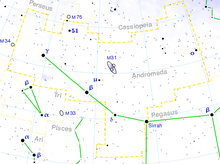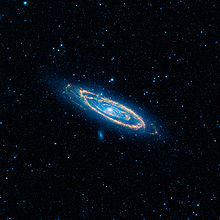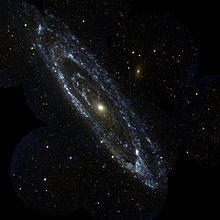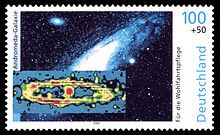- Andromeda Galaxy
-
Andromeda Galaxy 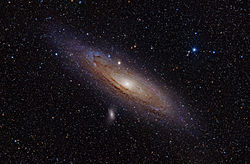
The Andromeda GalaxyObservation data (J2000 epoch) Pronunciation  /ænˈdrɒmədə/
/ænˈdrɒmədə/Constellation Andromeda Right ascension 00h 42m 44.3s[1] Declination +41° 16′ 9″[1] Redshift z = −0.001
(minus sign
indicates blueshift)Helio radial velocity −301 ± 1 km/s[2] Distance 2.54 ± 0.06 Mly
(778 ± 17 kpc)[3][2][4][5][6][a]Type SA(s)b[1] Number of stars 1 trillion (1012) [7] Apparent dimensions (V) 190′ × 60′[1] Apparent magnitude (V) 3.44[8][9] Other designations M31, NGC 224, UGC 454, PGC 2557, 2C 56 (Core),[1] LEDA 2557 See also: Galaxy, List of galaxies The Andromeda Galaxy (
 /ænˈdrɒmədə/) is a spiral galaxy approximately 2.5 million light-years from Earth[4] in the constellation Andromeda. It is also known as Messier 31, M31, or NGC 224, and is often referred to as the Great Andromeda Nebula in older texts. Andromeda is the nearest spiral galaxy to the Milky Way, but not the closest galaxy overall. It gets its name from the area of the sky in which it appears, the Andromeda constellation, which was named after the mythological princess Andromeda. Andromeda is the largest galaxy of the Local Group, which consists of the Andromeda Galaxy, the Milky Way, the Triangulum Galaxy, and about 30 other smaller galaxies. Although the largest, Andromeda may not be the most massive, as recent findings suggest that the Milky Way contains more dark matter and may be the most massive in the grouping.[10] The 2006 observations by the Spitzer Space Telescope revealed that M31 contains one trillion (1012) stars,[7]: at least twice more than the number of stars in our own galaxy, which is estimated to be c. 200–400 billion.[11]
/ænˈdrɒmədə/) is a spiral galaxy approximately 2.5 million light-years from Earth[4] in the constellation Andromeda. It is also known as Messier 31, M31, or NGC 224, and is often referred to as the Great Andromeda Nebula in older texts. Andromeda is the nearest spiral galaxy to the Milky Way, but not the closest galaxy overall. It gets its name from the area of the sky in which it appears, the Andromeda constellation, which was named after the mythological princess Andromeda. Andromeda is the largest galaxy of the Local Group, which consists of the Andromeda Galaxy, the Milky Way, the Triangulum Galaxy, and about 30 other smaller galaxies. Although the largest, Andromeda may not be the most massive, as recent findings suggest that the Milky Way contains more dark matter and may be the most massive in the grouping.[10] The 2006 observations by the Spitzer Space Telescope revealed that M31 contains one trillion (1012) stars,[7]: at least twice more than the number of stars in our own galaxy, which is estimated to be c. 200–400 billion.[11]Andromeda is estimated to be 7.1×1011 solar masses.[2] In comparison a 2009 study estimated that the Milky Way and Andromeda are about equal in mass,[12] while a 2006 study put the mass of the Milky Way at ~80% of the mass of Andromeda. The Andromeda Galaxy and the Milky Way are expected to collide in perhaps 4.5 billion years.
At an apparent magnitude of 3.4, the Andromeda Galaxy is notable for being one of the brightest Messier objects,[13] making it visible to the naked eye on moonless nights even when viewed from areas with moderate light pollution. Although it appears more than six times as wide as the full Moon when photographed through a larger telescope, only the brighter central region is visible to the naked eye or when viewed using binoculars or a small telescope.
Contents
Observation history
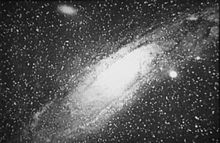 Great Andromeda Nebula by Isaac Roberts
Great Andromeda Nebula by Isaac Roberts
The Persian astronomer Abd al-Rahman al-Sufi wrote a tantalizing line about the chained constellation in his Book of Fixed Stars around 964, describing it as a "small cloud".[14][15] Star charts of that period have it labeled as the Little Cloud.[15] The first description of the object based on telescopic observation was given by German astronomer Simon Marius[15] in 1612. Charles Messier catalogued it as object M31 in 1764 and incorrectly credited Marius as the discoverer, unaware of Al Sufi's earlier work. In 1785, the astronomer William Herschel noted a faint reddish hue in the core region of the M31. He believed it to be the nearest of all the "great nebulae" and based on the colour and magnitude of the nebula, he incorrectly guessed that it was no more than 2,000 times the distance of Sirius.[16]
William Huggins in 1864 observed the spectrum of M31 and noted that it differed from a gaseous nebula.[17] The spectra of M31 displayed a continuum of frequencies, superimposed with dark absorption lines that help identify the chemical composition of an object. The Andromeda nebula was very similar to the spectra of individual stars, and from this it was deduced that M31 had a stellar nature. In 1885, a supernova (known as "S Andromedae") was seen in M31, the first and so far only one observed in that galaxy. At the time M31 was considered to be a nearby object, so the cause was thought to be a much less luminous and unrelated event called a nova, and was named accordingly "Nova 1885".[18]
The first photographs of M31 were taken in 1887 by Isaac Roberts from his private observatory in Sussex, England. The long-duration exposure allowed the spiral structure of the galaxy to be seen for the first time.[19] However, at the time this object was still commonly believed to be a nebula within our galaxy, and Roberts mistakenly believed that M31 and similar spiral nebulae were actually solar systems being formed, with the satellites nascent planets. The radial velocity of this object with respect to our solar system was measured in 1912 by Vesto Slipher at the Lowell Observatory, using spectroscopy. The result was the largest velocity recorded at that time, at 300 kilometres per second (190 mi/s), moving in the direction of the Sun.[20]
Island universe
In 1917, American astronomer Heber Curtis Olson observed a nova within M31. Searching the photographic record, 11 more novae were discovered. Curtis noticed that these novae were, on average, 10 magnitudes fainter than those that occurred elsewhere in the sky. As a result he was able to come up with a distance estimate of 500,000 light-years (3.2×1010 AU). He became a proponent of the so-called "island universes" hypothesis, which held that spiral nebulae were actually independent galaxies.[21]
In 1920, the Great Debate between Harlow Shapley and Curtis took place, concerning the nature of the Milky Way, spiral nebulae, and the dimensions of the universe. To support his claim that the Great Andromeda Nebula (M31) was an external galaxy, Curtis also noted the appearance of dark lanes resembling the dust clouds in our own Galaxy, as well as the significant Doppler shift. In 1922 Ernst Öpik presented a very elegant and simple astrophysical method to estimate the distance of M31. His result put the Andromeda Nebula far outside our Galaxy at a distance of about 450,000 parsec, which is about 1,500,000 ly.[22] Edwin Hubble settled the debate in 1925 when he identified extragalactic Cepheid variable stars for the first time on astronomical photos of M31. These were made using the 2.5 metre (100 in) Hooker telescope, and they enabled the distance of Great Andromeda Nebula to be determined. His measurement demonstrated conclusively that this feature was not a cluster of stars and gas within our Galaxy, but an entirely separate galaxy located a significant distance from our own.[23]
 Stars in the Andromeda Galaxy's disc[24]
Stars in the Andromeda Galaxy's disc[24]
Andromeda plays an important role in galactic studies, since it is the nearest spiral galaxy (although not the nearest galaxy). In 1943, Walter Baade was the first person to resolve stars in the central region of the Andromeda Galaxy. Based on his observations of this galaxy, he was able to discern two distinct populations of stars based on their metallicity, naming the young, high velocity stars in the disk Type I and the older, red stars in the bulge Type II. This nomenclature was subsequently adopted for stars within the Milky Way, and elsewhere. (The existence of two distinct populations had been noted earlier by Jan Oort.)[25] Dr. Baade also discovered that there were two types of Cepheid variables, which resulted in a doubling of the distance estimate to M31, as well as the remainder of the Universe.[26]
Radio emission from the Andromeda Galaxy was first detected by Hanbury Brown and Cyril Hazard at Jodrell Bank Observatory using the 218-ft Transit Telescope, which were announced in 1950[27] (earlier observations were made by radio astronomy pioneer Grote Reber in 1940, but were inconclusive, and were later shown to be an order of magnitude too high). The first radio maps of the galaxy were made in the 1950s by John Baldwin and collaborators at the Cambridge Radio Astronomy Group.[28] The core of the Andromeda Galaxy is called 2C 56 in the 2C radio astronomy catalogue. In 2009, the first planet may have been discovered in the Andromeda Galaxy. This candidate was detected using a technique called microlensing, which is caused by the deflection of light by a massive object.[29]
General
The measured distance to the Andromeda Galaxy was doubled in 1953 when it was discovered that there is another, dimmer type of Cepheid. In the 1990s, measurements of both standard red giants as well as red clump stars from the Hipparcos satellite measurements were used to calibrate the Cepheid distances.[30][31]
Origins
According to a team of astronomers reporting in 2010, Andromeda was formed out of the collision of two smaller galaxies between 5 and 9 billion years ago.[32]
Recent distance estimate
At least four distinct techniques have been used to measure distances to the Andromeda Galaxy.
In 2003, using the infrared surface brightness fluctuations (I-SBF) and adjusting for the new period-luminosity value of Freedman et al. 2001 and using a metallicity correction of −0.2 mag dex−1 in (O/H), an estimate of 2.57 ± 0.06 megalight-years (790 ± 18 kpc) was derived.
Using the Cepheid variable method, an estimate of 2.51 ± 0.13 Mly (770 ± 40 kpc) was achieved in 2004.[3][2]
In 2005, a group of astronomers consisting of Ignasi Ribas (CSIC, Institute for Space Studies of Catalonia (IEEC)) and his colleagues announced the discovery of an eclipsing binary star in the Andromeda Galaxy. The binary star, designated M31VJ00443799+4129236,[c] has two luminous and hot blue stars of types O and B. By studying the eclipses of the stars, which occur every 3.54969 days, the astronomers were able to measure their sizes. Knowing the sizes and temperatures of the stars they were able to measure the absolute magnitude of the stars. When the visual and absolute magnitudes are known, the distance to the star can be measured. The stars lie at the distance of 2.52 ± 0.14 megalight-years (770 ± 43 kpc) and the whole Andromeda Galaxy at about 2.5 Mly (770 kpc).[4] This new value is in excellent agreement with the previous, independent Cepheid-based distance value.
Andromeda is close enough that the Tip of the Red Giant Branch (TRGB) method may also be used to estimate its distance. The estimated distance to M31 using this technique in 2005 yielded 2.56 ± 0.08 Mly (780 ± 25 kpc).[5]
Averaged together, all these distance measurements give a combined distance estimate of 2.54 ± 0.06 Mly (780 ± 18 kpc).[a] Based upon the above distance, the diameter of M31 at the widest point is estimated to be 141 ± 3 kly (43,000 ± 920 pc).[d] Applying trigonometry (arctangent), that figures to extending at an apparent 3.18° angle in the sky.
Mass and luminosity estimates
Mass estimates for the Andromeda halo (including dark matter) give a value of approximately 1.23×1012 M☉[33] (or 1.2 trillion solar masses) compared to 1.9×1012 M☉ for the Milky Way. Thus M31 may be less massive than our own galaxy, although the error range is still too large to say for certain. Even so, the masses of the Milky Way and M31 are comparable, and M31's spheroid actually has a higher stellar density than that of the Milky Way.[34]
In particular, M31 appears to have significantly more common stars than the Milky Way, and the estimated luminosity of M31, ~2.6×1010 L☉, is about 25% higher than that of our own galaxy.[35] However the rate of star formation in the Milky Way is much higher, with M31 only producing about one solar mass per year compared to 3–5 solar masses for the Milky Way. The rate of supernovae in the Milky Way is also double that of M31.[36] This suggests that M31 once experienced a great star formation phase, but is now in a relative state of quiescence, whereas the Milky Way is experiencing more active star formation.[35] Should this continue, the luminosity in the Milky Way may eventually overtake that of M31.
 Local group (clickable map)
Local group (clickable map)Structure
 The Andromeda Galaxy seen in infrared by the Spitzer Space Telescope, one of NASA's four Great Space Observatories
The Andromeda Galaxy seen in infrared by the Spitzer Space Telescope, one of NASA's four Great Space Observatories
 Image of the Andromeda Galaxy taken by Spitzer in infrared, 24 micrometres (Credit:NASA/JPL–Caltech/K. Gordon, University of Arizona)
Image of the Andromeda Galaxy taken by Spitzer in infrared, 24 micrometres (Credit:NASA/JPL–Caltech/K. Gordon, University of Arizona) A Swift Tour of Andromeda Galaxy
A Swift Tour of Andromeda Galaxy
Based on its appearance in visible light, the Andromeda Galaxy is classified as an SA(s)b galaxy in the de Vaucouleurs-Sandage extended classification system of spiral galaxies.[1] However, data from the 2MASS survey showed that the bulge of M31 has a box-like appearance, which implies that the galaxy is actually a barred spiral galaxy like the Milky Way, with the Andromeda Galaxy's bar viewed almost directly along its long axis.[37]
In 2005, astronomers used the Keck telescopes to show that the tenuous sprinkle of stars extending outward from the galaxy is actually part of the main disk itself.[38] This means that the spiral disk of stars in Andromeda is three times larger in diameter than previously estimated. This constitutes evidence that there is a vast, extended stellar disk that makes the galaxy more than 220,000 light-years (67,000 pc) in diameter. Previously, estimates of Andromeda's size ranged from 70,000 to 120,000 light-years (21,000 to 37,000 pc) across.
The galaxy is inclined an estimated 77° relative to the Earth (where an angle of 90° would be viewed directly from the side). Analysis of the cross-sectional shape of the galaxy appears to demonstrate a pronounced, S-shaped warp, rather than just a flat disk.[39] A possible cause of such a warp could be gravitational interaction with the satellite galaxies near M31. The galaxy M33 could be responsible for some warp in M31's arms, though more precise distances and radial velocities are required.
Spectroscopic studies have provided detailed measurements of the rotational velocity of M31 at various radii from the core. In the vicinity of the core, the rotational velocity climbs to a peak of 225 kilometres per second (140 mi/s) at a radius of 1,300 light-years (82,000,000 AU), then descends to a minimum at 7,000 light-years (440,000,000 AU) where the rotation velocity may be as low as 50 kilometres per second (31 mi/s). Thereafter the velocity steadily climbs again out to a radius of 33,000 light-years (2.1×109 AU), where it reaches a peak of 250 kilometres per second (160 mi/s). The velocities slowly decline beyond that distance, dropping to around 200 kilometres per second (120 mi/s) at 80,000 light-years (5.1×109 AU). These velocity measurements imply a concentrated mass of about 6×109 M☉ in the nucleus. The total mass of the galaxy increases linearly out to 45,000 light-years (2.8×109 AU), then more slowly beyond that radius.[40]
The spiral arms of Andromeda are outlined by a series of H II regions that Baade described as resembling "beads on a string". They appear to be tightly wound, although they are more widely spaced than in our galaxy.[41] Rectified images of the galaxy show a fairly normal spiral galaxy with the arms wound up in a clockwise direction. There are two continuous trailing arms that are separated from each other by a minimum of about 13,000 light-years (820,000,000 AU). These can be followed outward from a distance of roughly 1,600 light-years (100,000,000 AU) from the core. The most likely cause of the spiral pattern is thought to be interaction with M32. This can be seen by the displacement of the neutral hydrogen clouds from the stars.[42]
In 1998, images from the European Space Agency's Infrared Space Observatory demonstrated that the overall form of the Andromeda Galaxy may be transitioning into a ring galaxy. The gas and dust within Andromeda is generally formed into several overlapping rings, with a particularly prominent ring formed at a radius of 32,000 light-years (2.0×109 AU) from the core.[43] This ring is hidden from visible light images of the galaxy because it is composed primarily of cold dust.
Close examination of the inner region of Andromeda showed a smaller dust ring that is believed to have been caused by the interaction with M32 more than 200 million years ago. Simulations show that the smaller galaxy passed through the disk of Andromeda along the latter's polar axis. This collision stripped more than half the mass from the smaller M32 and created the ring structures in Andromeda.[44]
Studies of the extended halo of M31 show that it is roughly comparable to that of the Milky Way, with stars in the halo being generally "metal-poor", and increasingly so with greater distance.[45] This evidence indicates that the two galaxies have followed similar evolutionary paths. They are likely to have accreted and assimilated about 1–200 low-mass galaxies during the past 12 billion years.[46] The stars in the extended halos of M31 and the Milky Way may extend nearly one-third the distance separating the two galaxies.
Nucleus
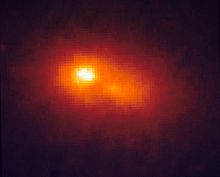 HST image of the Andromeda Galaxy core showing possible double structure. NASA/ESA photo
HST image of the Andromeda Galaxy core showing possible double structure. NASA/ESA photo
M31 is known to harbor a dense and compact star cluster at its very center. In a large telescope it creates a visual impression of a star embedded in the more diffuse surrounding bulge. The luminosity of the nucleus is in excess of the most luminous globular clusters.[citation needed]
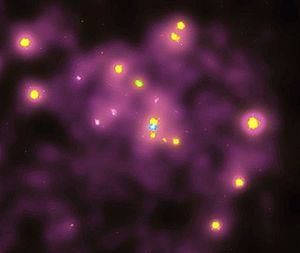 Chandra X-ray telescope image of the center of M31. A number of X-ray sources, likely X-ray binary stars, within Andromeda's central region appear as yellowish dots. The blue source at the center is at the position of the supermassive black hole.
Chandra X-ray telescope image of the center of M31. A number of X-ray sources, likely X-ray binary stars, within Andromeda's central region appear as yellowish dots. The blue source at the center is at the position of the supermassive black hole.
In 1991 Tod R. Lauer used WFPC, then on board the Hubble Space Telescope, to image Andromeda's inner nucleus. The nucleus consists of two concentrations separated by 1.5 parsecs (4.9 ly). The brighter concentration, designated as P1, is offset from the center of the galaxy. The dimmer concentration, P2, falls at the true center of the galaxy and contains a black hole measured at 3-5 × 107 M☉ in 1993,[47] and at 1.1–2.3 × 108 M☉ in 2005.[48]
Scott Tremaine has proposed that the observed double nucleus could be explained if P1 is the projection of a disk of stars in an eccentric orbit around the central black hole.[49] The eccentricity is such that stars linger at the orbital apocenter, creating a concentration of stars. P2 also contains a compact disk of hot, spectral class A stars. The A stars are not evident in redder filters, but in blue and ultraviolet light they dominate the nucleus, causing P2 to appear more prominent than P1.[50]
While at the initial time of its discovery it was hypothesized that the brighter portion of the double nucleus was the remnant of a small galaxy "cannibalized" by Andromeda,[51] this is no longer considered to be a viable explanation. The primary reason is that such a nucleus would have an exceedingly short lifetime due to tidal disruption by the central black hole. While this could be partially resolved if P1 had its own black hole to stabilize it, the distribution of stars in P1 does not suggest that there is a black hole at its center.[49]
Discrete sources
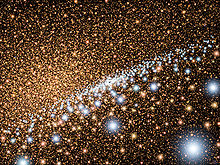 Artist's concept of the Andromeda Galaxy core showing a view across a disk of young, blue stars encircling a supermassive black hole. NASA/ESA photo
Artist's concept of the Andromeda Galaxy core showing a view across a disk of young, blue stars encircling a supermassive black hole. NASA/ESA photo
Apparently, by late 1968, no X-rays had been detected from the Andromeda Galaxy.[52] A balloon flight on October 20, 1970, set an upper limit for detectable hard X-rays from M31.[53]
Multiple X-ray sources have since been detected in the Andromeda Galaxy, using observations from the ESA's XMM-Newton orbiting observatory. Robin Barnard et al. hypothesized that these are candidate black holes or neutron stars, which are heating incoming gas to millions of kelvins and emitting X-rays. The spectrum of the neutron stars is the same as the hypothesized black holes, but can be distinguished by their masses.[54]
There are approximately 460 globular clusters associated with the Andromeda galaxy.[55] The most massive of these clusters, identified as Mayall II, nicknamed Globular One, has a greater luminosity than any other known globular cluster in the local group of galaxies.[56] It contains several million stars, and is about twice as luminous as Omega Centauri, the brightest known globular cluster in the Milky Way. Globular One (or G1) has several stellar populations and a structure too massive for an ordinary globular. As a result, some consider G1 to be the remnant core of a dwarf galaxy that was consumed by M31 in the distant past.[57] The globular with the greatest apparent brightness is G76 which is located in the south-west arm's eastern half.[15]
In 2005, astronomers discovered a completely new type of star cluster in M31. The new-found clusters contain hundreds of thousands of stars, a similar number of stars that can be found in globular clusters. What distinguishes them from the globular clusters is that they are much larger–several hundred light-years across–and hundreds of times less dense. The distances between the stars are, therefore, much greater within the newly discovered extended clusters.[58]
Satellites
Main article: Andromeda's satellite galaxiesLike the Milky Way, the Andromeda Galaxy has satellite galaxies, consisting of 14 known dwarf galaxies. The best known and most readily observed satellite galaxies are M32 and M110. Based on current evidence, it appears that M32 underwent a close encounter with M31 (Andromeda) in the past. M32 may once have been a larger galaxy that had its stellar disk removed by M31, and underwent a sharp increase of star formation in the core region, which lasted until the relatively recent past.[59]
M110 also appears to be interacting with M31, and astronomers have found a stream of metal-rich stars in the halo of M31 that appears to have been stripped from these satellite galaxies.[60] M110 does contain a dusty lane, which may indicate recent or ongoing star formation.[61]
In 2006 it was discovered that nine of these galaxies lay along a plane that intersects the core of the Andromeda Galaxy, rather than being randomly arranged as would be expected from independent interactions. This may indicate a common tidal origin for the satellites.[62]
Future collision of the Milky Way with Andromeda
Main article: Andromeda–Milky Way collisionThe Andromeda Galaxy is approaching the Milky Way at about 100 to 140 kilometres per second (62 to 87 mi/s) (400 lightyears every million years),[63] making it one of the few blueshifted galaxies. The Andromeda Galaxy and the Milky Way are thus expected to collide in about 4.5 billion years, although the details are uncertain since Andromeda's tangential velocity with respect to the Milky Way is only known to within about a factor of two.[64] A likely outcome of the collision is that the galaxies will merge to form a giant elliptical galaxy.[65] Such events are frequent among the galaxies in galaxy groups. The fate of the Earth and the Solar System in the event of a collision are currently unknown. If the galaxies do not merge, there is a small chance that the Solar System could be ejected from the Milky Way or join Andromeda.[66]
See also
- Galaxies in fiction
- List of Messier objects
- List of galaxies
- Mayall II – the largest globular cluster in the Andromeda Galaxy and in the Local Group
- New General Catalogue
- NGC 206 – the brightest star cloud in the Andromeda Galaxy
Notes
- ^ average(787 ± 18, 770 ± 40, 772 ± 44, 783 ± 25) = ((787 + 770 + 772 + 783) / 4) ± ((182 + 402 + 442 + 252)0.5 / 4) = 778 ± 17
- ^ Apparent Magnitude of 4.36 – distance modulus of 24.4 = −20.0
- ^ J00443799+4129236 is at celestial coordinates R.A. 00h 44m 37.99s, Dec. +41° 29′ 23.6″.
- ^ distance × tan( diameter_angle = 190′ ) = 141 ± 3 kly diameter
References
- ^ a b c d e f "Results for Messier 31". NASA/IPAC Extragalactic Database. NASA/IPAC. http://nedwww.ipac.caltech.edu/. Retrieved 2006-11-01.
- ^ a b c d Karachentsev, I. D.; Kashibadze, O. G. (2006). "Masses of the local group and of the M81 group estimated from distortions in the local velocity field". Astrophysics 49 (1): 3–18. Bibcode 2006Ap.....49....3K. doi:10.1007/s10511-006-0002-6.
- ^ a b Karachentsev, I. D.; et al. (2004). "A Catalog of Neighboring Galaxies". Astronomical Journal 127 (4): 2031–2068. Bibcode 2004AJ....127.2031K. doi:10.1086/382905.
- ^ a b c Ribas, I.; et al. (2005). "First Determination of the Distance and Fundamental Properties of an Eclipsing Binary in the Andromeda Galaxy". Astrophysical Journal Letters 635 (1): L37–L40. arXiv:astro-ph/0511045. Bibcode 2005ApJ...635L..37R. doi:10.1086/499161.
- ^ a b McConnachie, A. W.; et al. (2005). "Distances and metallicities for 17 Local Group galaxies". Monthly Notices of the Royal Astronomical Society 356 (4): 979–997. arXiv:astro-ph/0410489. Bibcode 2005MNRAS.356..979M. doi:10.1111/j.1365-2966.2004.08514.x.
- ^ Jensen, J. B.; et al. (2003). "Measuring Distances and Probing the Unresolved Stellar Populations of Galaxies Using Infrared Surface Brightness Fluctuations". Astrophysical Journal 583 (2): 712–726. arXiv:astro-ph/0210129. Bibcode 2003ApJ...583..712J. doi:10.1086/345430.
- ^ a b The Andromeda Galaxy hosts a trillion stars
- ^ "SIMBAD-M31". SIMBAD Astronomical Database. http://simbad.u-strasbg.fr/simbad/sim-id?Ident=M31. Retrieved 2009-11-29.
- ^ Armando, G. P.; et al. (2007). "The GALEX Ultraviolet Atlas of Nearby Galaxies". Astrophysical Journal 173 (2): 185–255. arXiv:astro-ph/0606440. Bibcode 2007ApJS..173..185G. doi:10.1086/516636.
- ^ Amos, J. (February 5, 2006). "Dark matter comes out of the cold". BBC News. http://news.bbc.co.uk/2/hi/science/nature/4679220.stm. Retrieved 2006-05-24.
- ^ Frommert, H.; Kronberg, C. (August 25, 2005). "The Milky Way Galaxy". SEDS. http://www.seds.org/messier/more/mw.html. Retrieved 2007-05-09.
- ^ "Milky Way a Swifter Spinner, More Massive, New Measurements Show". CfA Press Release No. 2009-03. Harvard-Smithsonian Center for Astrophysics. January 5, 2009. http://www.cfa.harvard.edu/press/2009/pr200903.html.
- ^ Frommert, H.; Kronberg, C. (August 22, 2007). "Messier Object Data, sorted by Apparent Visual Magnitude". SEDS. http://seds.lpl.arizona.edu/messier/dataMag.html. Retrieved 2007-08-27.
- ^ Henbest, N.; Couper, H. (1994). The guide to the galaxy. p. 31. ISBN 052145882X. http://books.google.com/?id=-TI4AAAAIAAJ&pg=PA31&dq&q=.
- ^ a b c d Kepple, G. R.; Sanner, G. W. (1998). The Night Sky Observer's Guide. Vol. 1. Willmann-Bell. p. 18. ISBN 0-943396-58-1.
- ^ Herschel, W. (1785). "On the Construction of the Heavens". Philosophical Transactions of the Royal Society of London 75 (0): 213–266. doi:10.1098/rstl.1785.0012.
- ^ Huggins, W.; Miller, W. A. (1864). "On the Spectra of Some of the Nebulae". Philosophical Transactions of the Royal Society of London 154 (0): 437–444. doi:10.1098/rstl.1864.0013.
- ^ Backhouse, T. W. (1888). "nebula in Andromeda and Nova, 1885". Monthly Notices of the Royal Astronomical Society 48: 108. Bibcode 1888MNRAS..48..108B.
- ^ Roberts, I. (1899). A Selection of Photographs of Stars, Star-clusters and Nebulae. II. London: Universal Press.
- ^ Slipher, V. M. (1913). "The Radial Velocity of the Andromeda Nebula". Lowell Observatory Bulletin 1: 56–57. Bibcode 1913LowOB...1b..56S.
- ^ Curtis, H. D. (1988). "Novae in Spiral Nebulae and the Island Universe Theory". Publications of the Astronomical Society of the Pacific 100: 6. Bibcode 1988PASP..100....6C. doi:10.1086/132128.
- ^ Öpik, E. (1922). "An estimate of the distance of the Andromeda Nebula". Astrophysical Journal 55: 406–410. Bibcode 1922ApJ....55..406O. doi:10.1086/142680.
- ^ Hubble, E. P. (1929). "A spiral nebula as a stellar system, Messier 31". Astrophysical Journal 69: 103–158. Bibcode 1929ApJ....69..103H. doi:10.1086/143167.
- ^ "Four Unusual Views of the Andromeda Galaxy". ESA/Hubble. 21 July 2011. http://www.spacetelescope.org/news/heic1112/. Retrieved 21 July 2011.
- ^ Baade, W. (1944). "The Resolution of Messier 32, NGC 205, and the Central Region of the Andromeda Nebula". Astrophysical Journal 100: 137. Bibcode 1944ApJ...100..137B. doi:10.1086/144650.
- ^ Gribbin, J. R. (2001). The Birth of Time: How Astronomers Measure the Age of the Universe. Yale University Press. p. 151. ISBN 0300089147.
- ^ Brown, R. Hanbury; Hazard, C. (1950). "Radio-frequency Radiation from the Great Nebula in Andromeda (M.31).". Nature 166: 901. Bibcode 1950Natur.166..901B. doi:10.1038/166901a0.Brown, R. Hanbury; Hazard, C. (1951). "Radio emission from the Andromeda nebula". MNRAS 111: 357. Bibcode 1951MNRAS.111..357B.
- ^ van der Kruit, P. C.; Allen, R. J. (1976). "The Radio Continuum Morphology of Spiral Galaxies". Annual Review of Astronomy and Astrophysics 14 (1): 417–445. Bibcode 1976ARA&A..14..417V. doi:10.1146/annurev.aa.14.090176.002221.
- ^ Ingrosso, G.; et al. (2009). "Pixel-lensing as a way to detect extrasolar planets in M31". Monthly Notices of the Royal Astronomical Society 399 (1): 219–228. arXiv:0906.1050. Bibcode 2009MNRAS.399..219I. doi:10.1111/j.1365-2966.2009.15184.x.
- ^ Holland, S. (1998). "The Distance to the M31 Globular Cluster System". Astronomical Journal 115 (5): 1916–1920. arXiv:astro-ph/9802088. Bibcode 1998astro.ph..2088H. doi:10.1086/300348.
- ^ Stanek, K. Z.; Garnavich, P. M (1998). "Distance to M31 With the HST and Hipparcos Red Clump Stars". Astrophysical Journal Letters 503 (2): 131–141. arXiv:astro-ph/9802121. Bibcode 1998ApJ...503L.131S. doi:10.1086/311539.
- ^ Moskvitch, Katia (25 November 2010). "Andromeda 'born in a collision'". BBC News. http://www.bbc.co.uk/news/science-environment-11833356. Retrieved 25 November 2010.
- ^ Evans, N. W.; Wilkinson, M. I. (2000). "The mass of the Andromeda Galaxy". Monthly Notices of the Royal Astronomical Society 316 (4): 929–942. arXiv:astro-ph/0004187. Bibcode 2000MNRAS.316..929E. doi:10.1046/j.1365-8711.2000.03645.x.
- ^ Kalirai, J. S.; et al. (2006). "The Metal-Poor Halo of the Andromeda Spiral Galaxy (M31)". Astrophysical Journal 648 (1): 389–404. arXiv:astro-ph/0605170. Bibcode 2006astro.ph..5170K. doi:10.1086/505697.
- ^ a b van den Bergh, S. (1999). "The local group of galaxies". Astronomy and Astrophysics Review 9 (3–4): 273–318. Bibcode 1999A&ARv...9..273V. doi:10.1007/s001590050019.
- ^ Liller, W.; Mayer, B. (1987). "The Rate of Nova Production in the Galaxy". Publications of the Astronomical Society of the Pacific 99: 606–609. Bibcode 1987PASP...99..606L. doi:10.1086/132021.
- ^ Beaton, R. L.; et al. (2006). "Unveiling the Boxy Bulge and Bar of the Andromeda Spiral Galaxy". Astrophysical Journal Letters 658 (2): L91. arXiv:astro-ph/0605239. Bibcode 2006astro.ph..5239B. doi:10.1086/514333.
- ^ Chapman, S. C.; et al. (2006). "A kinematically selected, metal-poor spheroid in the outskirts of M31". Astrophysical Journal 653 (1): 255. arXiv:astro-ph/0602604. Bibcode 2006ApJ...653..255C. doi:10.1086/508599. Also see the press release, "Andromeda's Stellar Halo Shows Galaxy's Origin to Be Similar to That of Milky Way" (Press release). Caltech Media Relations. February 27, 2006. http://pr.caltech.edu/media/Press_Releases/PR12801.html. Retrieved 2006-05-24.
- ^ "Astronomers Find Evidence of an Extreme Warp in the Stellar Disk of the Andromeda Galaxy" (Press release). UC Santa Cruz. January 9, 2001. http://www.ucsc.edu/news_events/press_releases/archive/00-01/01-01/andromeda.html. Retrieved 2006-05-24.
- ^ Rubin, V. C.; Ford, W. K. J. (1970). "Rotation of the Andromeda Nebula from a Spectroscopic Survey of Emission". Astrophysical Journal 159: 379. Bibcode 1970ApJ...159..379R. doi:10.1086/150317.
- ^ Arp, H. (1964). "Andromeda Nebula from a Spectroscopic Survey of Emission". Astrophysical Journal 139: 1045. Bibcode 1964ApJ...139.1045A. doi:10.1086/147844.
- ^ Braun, R. (1991). "The distribution and kinematics of neutral gas, HI region in M31". Astrophysical Journal 372: 54–66. Bibcode 1991ApJ...372...54B. doi:10.1086/169954.
- ^ "ISO unveils the hidden rings of Andromeda" (Press release). European Space Agency. October 14, 1998. http://sci.esa.int/science-e/www/object/index.cfm?fobjectid=12748. Retrieved 2006-05-24.
- ^ "Busted! Astronomers Nab Culprit in Galactic Hit-and-Run". Harvard-Smithsonian Center for Astrophysics. October 18, 2006. http://www.cfa.harvard.edu/press/pr0628.html. Retrieved 2006-10-18.
- ^ Kalirai, J. S.; et al. (2006). "The Metal-Poor Halo of the Andromeda Spiral Galaxy (M31)". Astrophysical Journal 648 (1): 389. arXiv:astro-ph/0605170. Bibcode 2006astro.ph..5170K. doi:10.1086/505697.
- ^ Bullock, J. S.; Johnston, K.V. (2005). "Tracing Galaxy Formation with Stellar Halos I: Methods". Astrophysical Journal 635 (2): 931–949. arXiv:astro-ph/0506467. Bibcode 2005ApJ...635..931B. doi:10.1086/497422.
- ^ Lauer, T. R.; et al. (1993). "Planetary camera observations of the double nucleus of M31". Astronomical Journal 106 (4): 1436–1447, 1710–1712. Bibcode 1993AJ....106.1436L. doi:10.1086/116737.
- ^ Bender, Ralf; et al. (2005). "HST STIS Spectroscopy of the Triple Nucleus of M31: Two Nested Disks in Keplerian Rotation around a Supermassive Black Hole". Astrophysical Journal 631 (1): 280–300. arXiv:astro-ph/0509839. Bibcode 2005ApJ...631..280B. doi:10.1086/432434.
- ^ a b Tremaine, S. (1995). "An Eccentric-Disk Model for the Nucleus of M31". Astronomical Journal 110: 628–633. arXiv:astro-ph/9502065. Bibcode 1995AJ....110..628T. doi:10.1086/117548.
- ^ "Hubble Space Telescope Finds a Double Nucleus in the Andromeda Galaxy" (Press release). Hubble News Desk. July 20, 1993. http://hubblesite.org/newscenter/newsdesk/archive/releases/1993/18/text/. Retrieved 2006-05-26.
- ^ Schewe, P. F.; Stein, Ben. "The Andromeda Galaxy has a Double Nucleus". Physics News Update (American Institute of Physics). http://www.aip.org/pnu/1993/split/pnu138-2.htm. Retrieved 2009-07-10.
- ^ Fujimoto, M.; Hayakawa, S.; Kato, T. (1969). "Correlation between the Densities of X-Ray Sources and Interstellar Gas". Astrophysics and Space Science 4 (1): 64–83. Bibcode 1969Ap&SS...4...64F. doi:10.1007/BF00651263.
- ^ Peterson, L. E. (1973). "Hard Cosmic X-Ray Sources". In Bradt, H.; Giacconi, R.. X- and Gamma-Ray Astronomy, Proceedings of IAU Symposium no. 55 held in Madrid, Spain, 11–13 May 1972. International Astronomical Union. pp. 51–73. Bibcode 1973IAUS...55...51P.
- ^ Barnard, R.; Kolb, U.; Osborne, J.P. (2005). "Timing the bright X-ray population of the core of M31 with XMM-Newton". arXiv:astro-ph/0508284 [astro-ph].
- ^ Barmby, P.; Huchra, J. P. (2001). "M31 Globular Clusters in the Hubble Space Telescope Archive. I. Cluster Detection and Completeness". Astronomical Journal 122 (5): 2458–2468. arXiv:astro-ph/0107401. Bibcode 2001AJ....122.2458B. doi:10.1086/323457.
- ^ "Hubble Spies Globular Cluster in Neighboring Galaxy" (Press release). Hubble news desk STSci-1996-11. April 24, 1996. http://hubblesite.org/newscenter/newsdesk/archive/releases/1996/11/. Retrieved 2006-05-26.
- ^ Meylan, G.; et al. (2001). "G1 in M31 - Giant Globular Cluster or Core of a Dwarf Elliptical Galaxy?". Astronomical Journal 122 (2): 830–841. arXiv:astro-ph/0105013. Bibcode 2001AJ....122..830M. doi:10.1086/321166.
- ^ Huxor, A. P.; et al. (2005). "A new population of extended, luminous, star clusters in the halo of M31". Monthly Notices of the Royal Astronomical Society 360 (3): 993–1006. arXiv:astro-ph/0412223. Bibcode 2005MNRAS.360.1007H. doi:10.1111/j.1365-2966.2005.09086.x.
- ^ Bekki, K.; et al. (2001). "A New Formation Model for M32: A Threshed Early-type Spiral?". Astrophysical Journal Letters 557 (1): L39–L42. arXiv:astro-ph/0107117. Bibcode 2001ApJ...557L..39B. doi:10.1086/323075.
- ^ Ibata, R.; et al. (2001). "A giant stream of metal-rich stars in the halo of the galaxy M31". Nature 412 (6842): 49–52. doi:10.1038/35083506. PMID 11452300.
- ^ Young, L. M. (2000). "Properties of the Molecular Clouds in NGC 205". Astronomical Journal 120 (5): 2460–2470. arXiv:astro-ph/0007169. Bibcode 2000AJ....120.2460Y. doi:10.1086/316806.
- ^ Koch, A.; Grebel, E. K. (2006). "The Anisotropic Distribution of M 31 Satellite Galaxies: A Polar Great Plane of Early-Type Companions". Astronomical Journal 131 (3): 1405–1415. arXiv:astro-ph/0509258. Bibcode 2005astro.ph..9258K. doi:10.1086/499534.
- ^ Malik, T. (May 7, 2002). "Crash Course: Simulating the Fate of Our Milky Way". Space.com. http://www.space.com/scienceastronomy/astronomy/galaxy_collides_020507-1.html. Retrieved 2006-09-18.[dead link]
- ^ "The Grand Collision". The Sky At Night. November 5, 2007.
- ^ Cox, T. J.; Loeb, A. (2008). "The collision between the Milky Way and Andromeda". Monthly Notices of the Royal Astronomical Society 386 (1): 461–474. Bibcode 2008MNRAS.tmp..333C. doi:10.1111/j.1365-2966.2008.13048.x.
- ^ Cain, F. (2007). "When Our Galaxy Smashes Into Andromeda, What Happens to the Sun?". Universe Today. http://www.universetoday.com/2007/05/10/when-our-galaxy-smashes-into-andromeda-what-happens-to-the-sun/. Retrieved 2007-05-16.
External links
- StarDate: M31 Fact Sheet
- Simbad data on M31
- Messier 31, SEDS Messier pages
- Astronomy Picture of the Day
- A Giant Globular Cluster in M31 1998 October 17.
- M31: The Andromeda Galaxy 2004 July 18.
- Andromeda Island Universe 2005 December 22.
- Andromeda Island Universe 2010 January 9.
- WISE Infrared Andromeda 2010 February 19
- M31 and it's central Nuclear Spiral
- Amateur photography - M31
- Globular Clusters in M31 at The Curdridge Observatory
- First direct distance to Andromeda − Astronomy magazine article
- Andromeda galaxy at SolStation.com
- Andromeda Galaxy at The Encyclopedia of Astrobiology, Astronomy, & Spaceflight
- M31, the Andromeda Galaxy at NightSkyInfo.com
- Ker Than (January 23, 2006). "Strange Setup: Andromeda's Satellite Galaxies All Lined Up". SPACE.com. http://space.com/scienceastronomy/060123_andromeda_plane.html.
- The Andromeda Galaxy on WikiSky: DSS2, SDSS, GALEX, IRAS, Hydrogen α, X-Ray, Astrophoto, Sky Map, Articles and images
- Hubble Finds Mysterious Disk of Blue Stars Around Black Hole Hubble observations (Sep 20 2005) put the mass of the Andromeda core black hole at 140 million solar masses
- M31 (Apparent) Novae Page (IAU)
Messier objects List M1 · M2 · M3 · M4 · M5 · M6 · M7 · M8 · M9 · M10 · M11 · M12 · M13 · M14 · M15 · M16 · M17 · M18 · M19 · M20 · M21 · M22 · M23 · M24 · M25 · M26 · M27 · M28 · M29 · M30 · M31 · M32 · M33 · M34 · M35 · M36 · M37 · M38 · M39 · M40 · M41 · M42 · M43 · M44 · M45 · M46 · M47 · M48 · M49 · M50 · M51 · M52 · M53 · M54 · M55 · M56 · M57 · M58 · M59 · M60 · M61 · M62 · M63 · M64 · M65 · M66 · M67 · M68 · M69 · M70 · M71 · M72 · M73 · M74 · M75 · M76 · M77 · M78 · M79 · M80 · M81 · M82 · M83 · M84 · M85 · M86 · M87 · M88 · M89 · M90 · M91 · M92 · M93 · M94 · M95 · M96 · M97 · M98 · M99 · M100 · M101 · M102 · M103 · M104 · M105 · M106 · M107 · M108 · M109 · M110See also Categories:- Spiral galaxies
- Unbarred spiral galaxies
- Local Group
- Andromeda Galaxy
- Andromeda Subgroup
- Andromeda constellation
- Messier objects
- NGC objects
- PGC objects
- UGC objects
- LEDA objects
Wikimedia Foundation. 2010.

